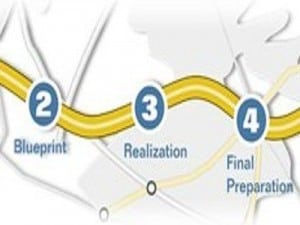Lots of literature, information, and resources focus on change management for successful enterprise application projects. To address SAP change management, the SAP Activate Methodology provides resources, tools, and templates, along with guidance for Change Management during your SAP project.
Even though the Activate methodology and various other resources provide some great information, the high-level guiding framework always seems to be somewhat vague. For example, businesses receive a constant message that people resist change and that it is so hard. That is not true. As I have often said, if people resisted change, no new product or service would ever be sold. No new invention, gadget, method, or anything else would ever be developed. We would see no innovation in anything.
People do not simply resist change. They resist change they do not understand and change they perceive as a threat.
Applying Sales and Marketing Principles to SAP Change Management
If sales and marketing departments for every type of organization in the world manage to sell new products or services, maybe we should look to them for what works. For both marketing and sales, customer who are considering a purchase experience four key phases:
- Awareness (Marketing)
- Consideration (Marketing, sales)
- Evaluation (Sales, marketing)
- Purchase (Sales)
These four general stages or phases of buyer behavior correlate well to a solid change management program: messaging, engagement, credibility, and commitment. To be successful, you must be committed to Leading Change (and Change Management).
1. Messaging – This is the beginning of the stakeholder analysis process. Exploration, active listening, and facilitation are critical. At this stage, messaging is outbound.
Product or Service Sales Phase
Awareness
Customers understand and can communicate their desire or problem or need. What are your constituents facing? What are their struggles, and what will help them do what they need to do better? If the change will add more burden to them, then why is the change necessary?
Enterprise Change Phase
Discovery and blueprinting
A good SAP or enterprise application change program must start right from the beginning of the project. First, key stakeholders must be identified at all levels of the organization. Afterward, a clear effort must focus on the benefits to the affected users. You must focus on the why of Achieving Business Value from SAP Investment.
A system-centric blueprint that does not connect to user needs will only breed mistrust and fear.
Analysis
Surveys are distributed, and results are tabulated.
2. Engagement – Deeper determination of the issues, active communication, and targeted messaging. Stakeholders at all levels must be encouraged to participate and listened to. At this stage, communications and messaging just start to go both ways (inbound and outbound).
Product or Service Sales Phase
Consideration
Marketing and communications are directed at addressing customer desires, problems, or needs. Assurances are provided that the product or service will meet those issues. The customer begins to solidify whether or not to explore a purchase decision.
Enterprise Change Phase
System functionality demonstrations and stakeholder feedback
Key stakeholders have the first part of their issues addressed. Each user fits into one of four key types of change categories:
- Opposed
- Unsure, anxious, or fearful
- Accepting or willing
- Promoting
This phase of the change process is designed to aggressively uncover and then address those who are opposed or anxious about the upcoming changes. These key stakeholders must be heard and their concerns answered. It is also where the key message around SAP Service Delivery versus Value Delivery is promoted.
Analysis
Survey results are synthesized, reviewed, and then communicated to the broader enterprise. Action plans to address the survey results are developed. Any evaluation metrics are defined.
3. Credibility – Benefits messages, demonstrations, insight, and information. More of an inbound and outbound dialog begins to occur. Change activities must promote openness and clearer understanding of the reasons for change.
Product or Service Sales Phase
Evaluation
Understanding of key features of a product or service and how they are different or better than competitors occurs. Price considerations are also important.
Enterprise Change Phase
Aggressive information sharing and open dialog
One way you can Achieve Business Benefit is Through SAP Prototype Demonstrations. Part of the communication and benefits program involves live system demonstrations (demo days), active engagement of super users, subject matter experts, and key change agents throughout the organization. Messaging would also include external web resources, links, presentations, and other information to help “sell” the organization on the coming changes.
The goal of this phase is to overcome objections, fear, and anxiety.
Analysis
Action plans from the surveys are communicated to the organization, and execution activities are carried out. Evaluation metrics are refined, communicated, and adjusted to the organizational requirements.
4. Commitment – Full user participation is critical at this stage. If they are not involved in the process, all of the previous effort falls apart here.
Product or Service Sales Phase
Purchase
For the purchase of a car, this is the test drive and price negotiation. For services or other items, this stage is the understanding of key differentiators and how the service will help or enhance the customer’s issue, customer references, and possibly case studies.
Whether the customer completes a test drive, or assesses differentiators, price negotiations, or the benefits of a product or service, these are all directly related to building a level of trust, which in turn produces commitment.
Enterprise Change Phase
Acceptance, Adoption, and Promotion
More user demonstrations, training, super user network, subject matter experts, and pilot processes are all important here. This is where everything starts to come together.
This stage is also where any changes to originally expected benefits or reductions in scope must be carefully managed. Another key area is the Organizational Change Management Inside the SAP IT Support Organization. A key component at this phase involves Change Management Strategies and Knowledge Transfer Processes for a Successful SAP Project 1 (and Part 2).
The goal of this phase is to produce acceptance and even promotion of the changes. However, acceptance, adoption, and promotion are not possible if the stakeholders have not established trust in the coming change.
Analysis
Execution activities are carried out and nearing completion. A review, analysis, and then distribution of the results of the previously defined metrics results occur. Lessons learned are captured and communicated.
Conclusion on SAP Change Management for Business Application Project Success
Every phase of your SAP or enterprise application project must be wrapped in the appropriate change management processes. Just as with sales and marketing, people do not resist change as much as they resist change that they perceive as a threat or do not understand. Because of this, the key is to learn to sell the change and its benefits to remove the perception of a threat. In doing so, you help to transform your project and company into a winner, both now and in the future.






